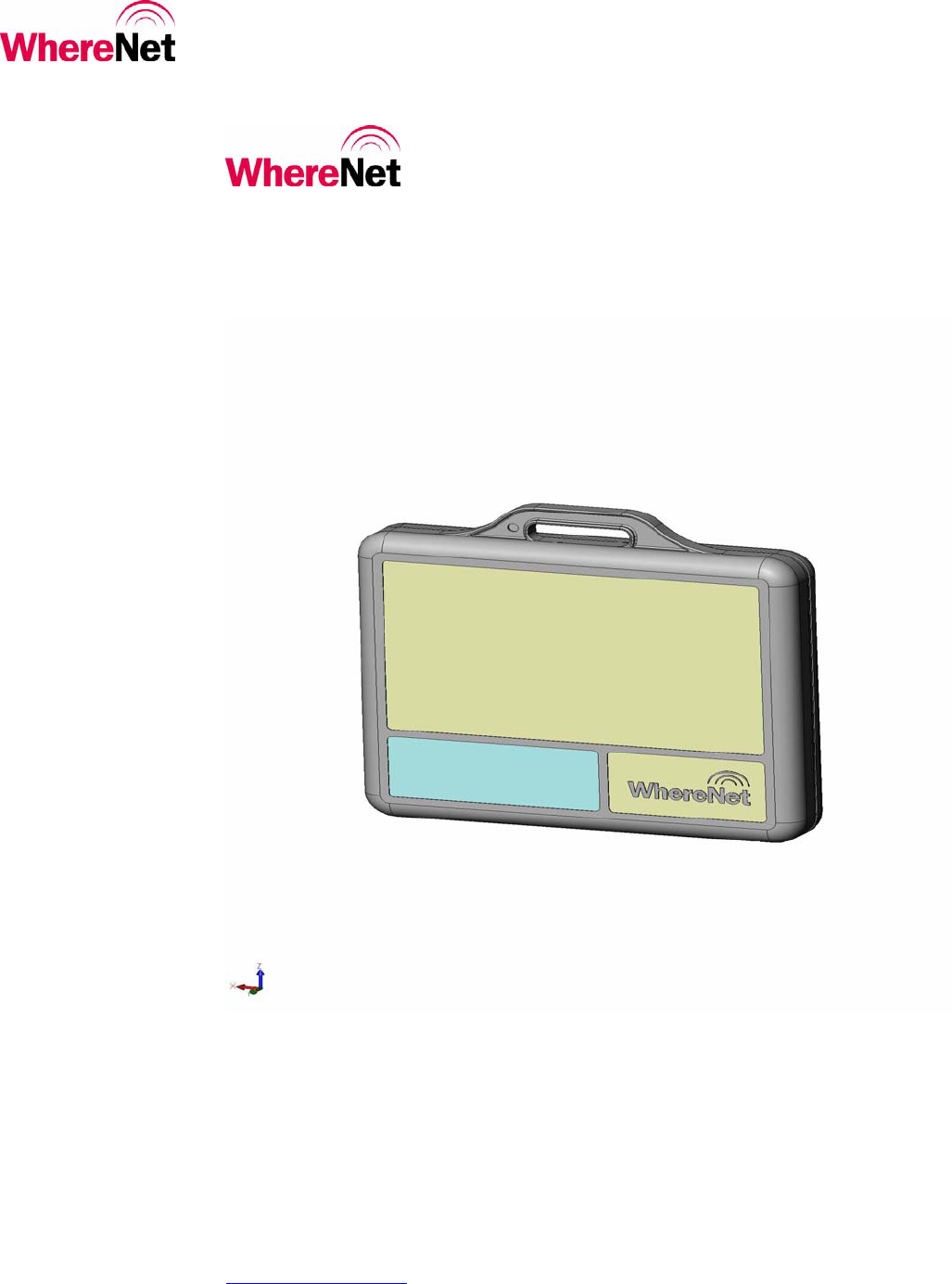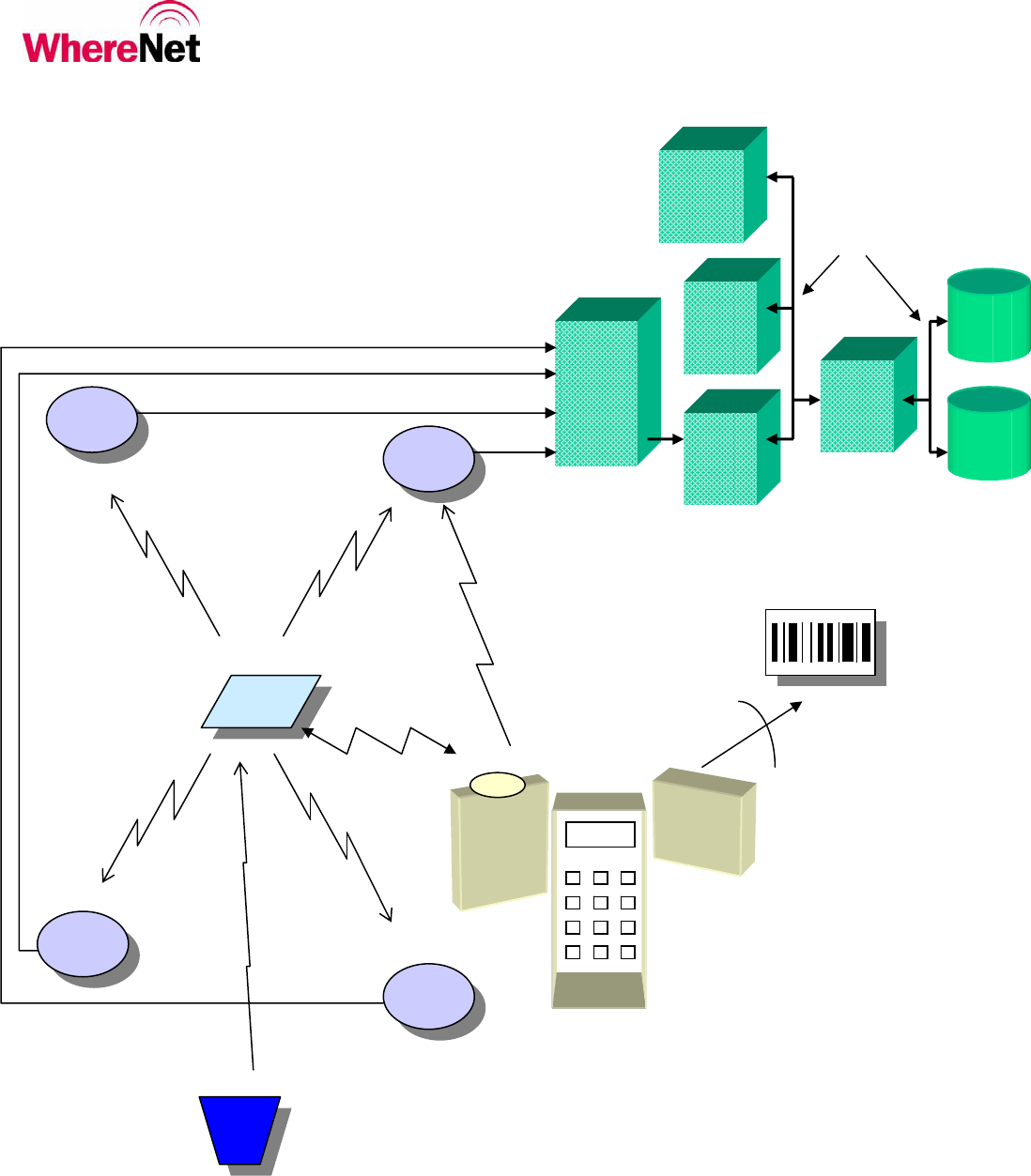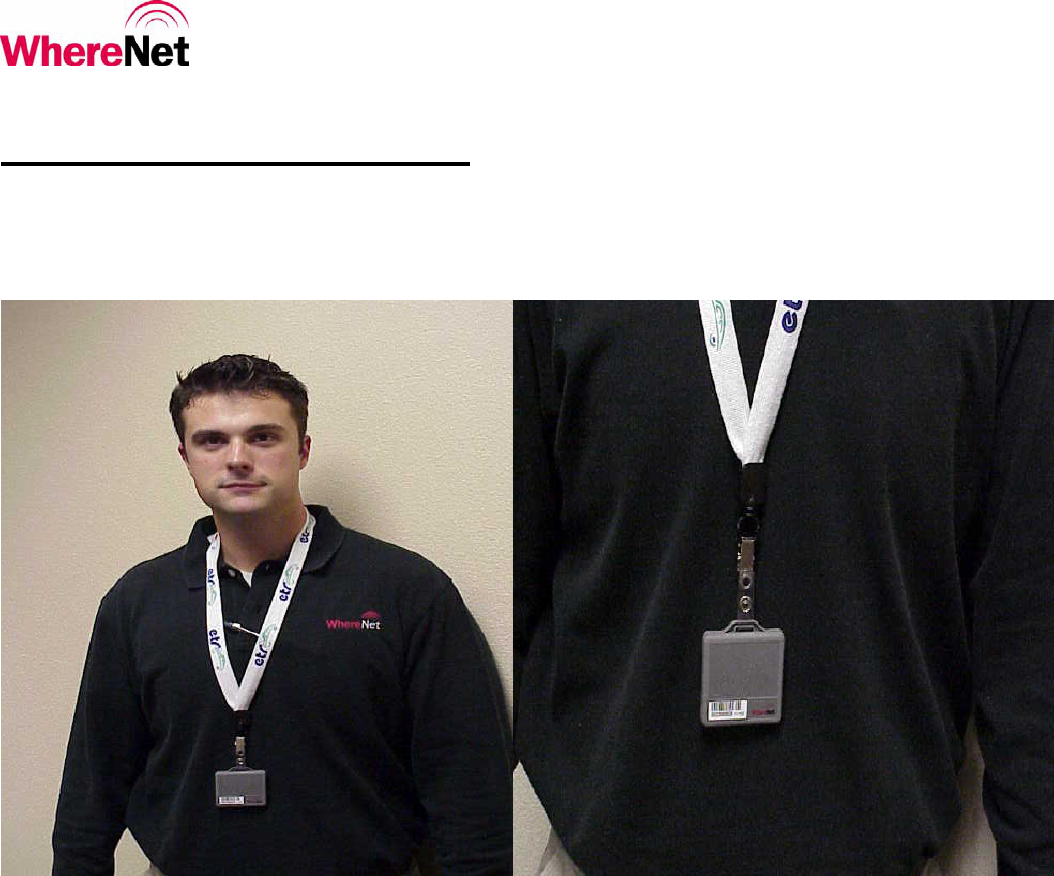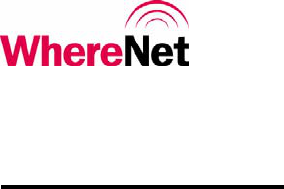Zebra Technologies TFF-1011L WhereTag III TL/TLB User Manual
Zebra Technologies Corporation WhereTag III TL/TLB Users Manual
Contents
- 1. Users Manual
- 2. User Manual
Users Manual

©WhereNet Corp. November 2005 TFF-1011-TL_TLB_UserMan_11_30_05 Page 1
WhereTag III TL/TLB
User’s Guide
Revision 01, November 2005
Model Number: TFF-1011
WhereNet Corp.
2858 De La Cruz Blvd.
Santa Clara, CA 95050
408-845-8500
WWW.WhereNet.COM

©WhereNet Corp. November 2005 TFF-1011-TL_TLB_UserMan_11_30_05 Page 2
FCC Requirements
This device must operate in compliance with Federal Communications Commission (FCC) Rules and Regulations Parts
15. See FCC registration label, located on the bottom of the equipment for the FCC, registration.
This equipment has been tested and found to comply with the limits for both Class A and Class B devices, pursuant to Part
15 of the FCC Rules.
This ISM device complies with Canadian ICES-001.
Cet appareil ISM est conforme à la norme NMB-001 du Canada.
Radio Equipment Authorization: FCC ID: NSQTFF-1011L
IC: 3586A-TFF1011L
RF Notice
The antenna(s) used for this transmitter must not be co-located or operating in conjunction with any other antenna or
transmitter.
Any changes or modifications to WhereNet Corp. equipment not expressly approved by WhereNet Corp. could void the
user’s authority to operate the equipment.
TL version: There are no user-serviceable parts inside. Do not attempt to open the unit to change
batteries.
TLB version: This product is designed to be able to replace the batteries inside. Important: refer to
battery replacement instructions to avoid resetting the tag.
_
________
_
_
________
_

©WhereNet Corp. November 2005 TFF-1011-TL_TLB_UserMan_11_30_05 Page 3
Contents
Introduction ........................................................................................................................4
Installation and Activation................................................................................................7
Tag Mounting Options.......................................................................................................7
Specifications ......................................................................................................................8

©WhereNet Corp. November 2005 TFF-1011-TL_TLB_UserMan_11_30_05 Page 4
Introduction
This User Guide describes the features, communication formats, configuration, and operation of the WhereTag. It includes
everything needed to be able to configure the tag and the communications between the tag and a host system.
Appendix A is a complete description of all the WhereTag commands together with examples of how they are
used to set up and operate the WhereTag. Appendix B is a physical description of the tag.
This chapter briefly describes the major features and components of the Real Time Location System.
The Real Time Location System
The WhereNet system tracks and locates items tagged with a WhereTag. Each tag emits short, low power bursts of widely
spread spectrum radio energy. These bursts are received by the system infrastructure. The infrastructure calculates the
location of the tagged item based on the different arrival times of the burst.
The WhereTag III TL or TLB is a compact battery operated radio frequency device. It is a component of the
WhereNet Real Time Location System.
The WhereNet Real Time Locating System (RTLS) is a precise local locating system with robust wireless
telemetry capabilities. Its integrated architecture meets all the requirements for an enterprise-wide wireless infrastructure
including locating, telemetry, and high-speed wireless communications.
WhereTags
WhereTags are attached to assets whose status must be quickly and accurately monitored. Examples are the movement of
a shipping container through a loading yard or a trailer through a warehousing facility.
RTLS uses DSSS RF technology to determine the location of WhereTag transmitting beacons. These
transmissions are extremely low power, about 2 mW. The transmissions can be received at distances in excess of 1,000
meters outdoors.
Because the transmissions are low power and spread across 60 MHz they add almost no RF pollution to the
environment. They can be readily used with wireless LANs and Blue Tooth devices without adversely affecting the
throughput of those systems.
The transmissions from the WhereTags are very resistant to interference because of the large amount of
processing gain. The system is able to receive signals that are below the RF noise floor of the surrounding environment.
WhereTags are located by measuring the difference in the arrival time of a signal at a minimum of three fixed-
position Location Sensors (the reliability increases if more than three sensors receive the signal). The WhereTags transmit
their keep alive signal at a programmable interval. The Location Sensors are in a grid formation that ensures that at least
three antennas can receive a blink from any place within the site. By comparing the difference in the arrival time of the
beacon signal at each of the receiving antennas the system can determine the location of the transmitting WhereTag. This
type of location determination is called TDOA (Time Difference Of Arrival). Tags are located to an accuracy of less than
ten feet in virtually all environments, indoors and out. The accuracy can be affected by environmental factors such as
concentrations of large metal objects.
Location Sensors
The Location Sensors are interconnected using standard Ethernet or connected wirelessly using 802.11b/g WiFi compliant
communications. One type of Location Sensor, called a Locating Access Point, (LAP) includes a full 802.11b/g Access
Point (AP). These integrated APs are from manufacturers such as Cisco, Symbol, and Intermec. Integration of these
standard APs allows complete compatibility with wireless LAN infrastructure. All the wireless services required within an
enterprise are then available on a single infrastructure.
WherePorts
The WherePort transmits a short range, adjustable from 5 to 20 feet, 127 kHz electro-magnetic signal. This signal defines
a field. The field may indicate an entry gate or transition point. Each WherePort is programmed with its own ID. When a

©WhereNet Corp November 2005 TFF-1011-TL_TLB_UserMan_11_30_05 Page 5
tag receive a WherePort trigger it transmits the WherePort ID along with its own ID to the location server. The server then
knows that the tagged object has entered the gate or completed a transition.
Because the location of the WherePorts is known, the server can locate the tag according to the WherePort field
even if the tag can not be located on the full X-Y coordinate grid of the location sensors.
Communication
The WhereTag has multiple types of transmissions, keep alive blinks, switch blinks, and WherePort/data blinks. The keep
alive blink is controlled by the WhereTag and blinks at the programmed interval. Switch blinks and WherePort/data blinks
are triggered by activity on a switch, a WherePort field, or a telemetry request from the host.
There are three formats for messages, short, medium, and long. The shortest one identifies the WhereTag and is
used for location processing. The longest transmission can include 88 bits of telemetry information. When connected to a
host microprocessor, additional information about the tagged item and its status can be transmitted.
The WhereNet system is scalable. A single Location Sensor and server can detect the presence of a WhereTag
within its 1,000 meter outdoor range. In addition, it can receive telemetry data, such as vehicle VINs, fuel status, and
mileage from WhereTag equipped vehicles. Or hundreds of Location Sensors can be interconnected to cover a site of
hundreds of acres and provide accurate X-Y coordinates for tracked assets on a map of the site.

©WhereNet Corp. November 2005 TFF-1011-TL_TLB_UserMan_11_30_05 Page 6
Figure 1. WhereNet Real Time
Locating System Block Diagram
Location
Antenna
GUI
Client
GUI
Client
RF
Client
and
Server
Location
Processor
2-way
communication
1-way spread
spectrum RF
1-way spread
spectrum RF for
sending tag ID
association with
bar code read
(Blink S/N &
telemetry) WhereTag III ST HO
WhereNet
Server
Indigenous
Network(s)
WhereNet
DBMS
Indigenous
MIS
DBMS
HPC
Bar
WhereWand
PCMCIA Scanner
Code
Laser bar code
WherePort
1-way FSK
Magnetic Field
Dimensions:
* Location Antenna – Location Antenna = 1000 ft indoor
* WhereTag III TL/TLB – Location Antenna = 1000 ft indoor
* WhereTag III TL/TLB - WhereWand = 1-2 ft
* WherePort- WhereTag III = 20 ft
Location
Antenna
Location
Antenna
Location
Antenna

©WhereNet Corp November 2005 TFF-1011-TL_TLB_UserMan_11_30_05 Page 7
Tag Mounting Options
Introduction
The WhereTag III TL/TLB device has a variety of ways to be mounted depending on the user’s needs. The following
mounting methods can be used:
With neck lanyard for personnel as seen in photo.
Pocket clip
Adhesive tape (for attachment to equipment)

©WhereNet Corp November 2005 TFF-1011-TL_TLB_UserMan_11_30_05 Page 8
Specifications (Subject to change without notice)
WhereTag III TL/TLB (Model #: TFF-1011-00BA & TFF-1011-00DA)
CAPABILITIES
Frequency Range 2.4 to 2.483 GHz
Typical Locate Range, Indoors 100 m (350 ft)
Typical Locate Range, Outdoors 300 m (1,000 ft)
Typical Read Range, Indoors 200 m (650 ft)
Typical Read Range, Outdoors 1,000 m (3,000 ft)
User Configurable Blink Rate 5 sec to 1 hr
WherePort Activation Up to 8 m
(20 ft) (With WherePort set for maximum power and optimum orientation.)
WIRED COMMUNICATION INTERFACE
Protocols RS-232c
RS-422/RS-485
TAG MOUNTING OPTONS
Tie wrap
Poly-lock
Adhesive tape
ELECTRICAL
Power............................................................ 2 x Coin Cell 3.0V Lithium Thionyl Chloride cell (The battery is not replaceable in TL.)
Typical Battery Life...................................... 4.5 years (dependent on blink rate and operating temperature)
ENVIRONMENTAL / PHYSICAL
Operating Temperature Range...................... -30º C to +65º C (-40º F to +149º F)
Storage Temperature Range.......................... -40º C to +70º C (-40º F to +158º F)
Durability...................................................... 1.8 m (6 ft) drop to concrete
Height ........................................................... 1.0 cm (0.4 in)
Length, without mounting tabs ..................... 6.45 cm (2.5 in)
Length, with mounting tabs .......................... 5.1 cm (2.0 in)
Width ............................................................ 4.4 cm (1.7 in)
Weight........................................................... 41 g (1.45 oz)
Environmental Sealing.................................. IP52
Case Material................................................ Molded Plastic (Nylon)
REGULATORY APPROVALS
- FCC, IC and EU R&TTE Directive